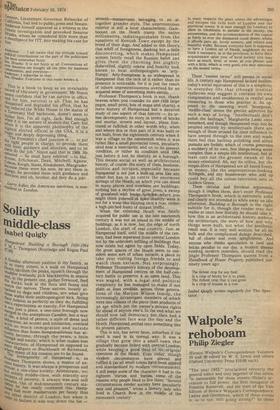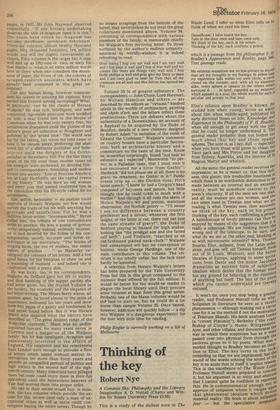Walpole's rehoboam
Philip Ziegler
Horace Walpole's Correspondence Volumes 35 and 36 edited by W. S. Lewis and others (Oxford University Press E10.00 each)
"The year 1933," proclaimed recently the general editor and only begetter of this series, "is memorable for three events: Hitler's accession to full power, the first inaugural of Franklin Roosevelt, and the start of the Yale Edition of Horace Walpole's Correspondence. Ladies and Gentlemen, which of these events is, so to say, still going strong?" In these pages, in 1937, Mr John Hayward observed respectfully, "If any literary undertaking deserves the title of magnum opus it is this." The years have rolled by, magnum has become jeroboam, jeroboam rehoboam.
Thirty-six volumes, almost twenty thousand pages, fifty thousand footnotes, ten million words: and still the mighty caravanserai ad vances. Fifty volumes is the target but it may well end up as fifty-one or -two, or sixty for that matter — what is an extra million words here or there when one considers the mountains of paper, the rivers of ink, the cohorts of ravaged research assistants which have already been consumed in this great enterprise?
Can any human being, however transcendent his talents or amazing his exploits, have earned this Everest among sarcophagi? What, in particular, can be the claims of Horace Walpole? He was rich, intelligent, and well connected. Agreeable sinecures were lavished on him; a seat found him in the House of Commons when he was only twenty-four, his sensitivities sharpened amid the glories of his father's great art collection at Houghton and polished by the 'grand tour.' The world was his for the taking, but when the time came to take it he shrank away, preferring the sheltered life of a dilettante publisher and bellelettriste amid the delights of his Gothic paradise at Strawberry Hill. For the last thirty years of his life even these modest taxes on his energies were eschewed; he devoted himself to correspondence, friendship and modest forays into society: "Loo at Princess Amelie's, loo at Lady Hertford's, are the capital events of my history." He was born an old woman and every year that passed confirmed him in the conviction that his life-style called for no amendment.
Idle, selfish, hedonistic — no puritan could approve of Horace Walpole; yet few would survey the fruits of his life with anything but gratitude and satisfaction. For he was a sublime letter-writer: "incomparable," Byron called him, the tribute of one consummate artist to another. He was a gossip of genius; witty; temperately unkind; endlessly interested in and diverted by the follies of his contemporaries; usually accurate and never extravagant in his inaccuracy. "The brains of singing birds, the roe of mullets, the sunny halves of peaches . . ."; so Macaulay catalogued the contents of his letters. Add a few good bones for the historian to chew on and a seasoning of mustard — and indeed one is confronted with a pretty dish. He was lucky, too, in his correspondents. Madame du Deffand gave her life to society and died babbling of the supper parties she had never given, but she rivalled Voltaire in the lucidity, the economy and the elegance of her letter-writing. The Misses Berry whom, all passion spent, he loved almost to the point of matrimony, enlivened his last years and drew from him pages of a gaiety and tenderness he had never found before. But it was Horace Mann who inspired what the editors have described as: "The great Andean range of the Walpolian continent." Mann was an undistinguished fuss-pot, for many years envoy in Florence and a hanger-on of the Walpole family; but he was intelligent, receptive and Passionately interested in the affairs of England. His existence and his remoteness from London were enough to provoke a flow of letters which lasted without serious interruption for more than forty years and provide an unequalled portrait of politics and high society in the second half of the eighteenth century. Many historians have pillaged them but none could enjoy them in their full splendour until the benevolent beavers of Yale had worried them into proper order. No ove in their senses would buy, in isolation, the two volumes which provide the excuse for this review (and only a man of exceptional riches as well as sense could contemplate buying the entire series). Though by no means scrapings from the bottom of the barrel, they nevertheless do not rival the great collections mentioned above. Volume 36, consisting of correspondence with various members of his family, is memorable chiefly for Walpole's first surviving letter. To those surfeited by the author's endless urbanity, saturated by worldly-wisdom, it is indeed refreshing to read:
Dear mama I hop you are wall and I am very wall and I hop papa is wall and I hop al was wall and my cosans liks thers pla things vary wall and I hop Dolly phillips is wall and pray give my Duty to papa and I am very glad to hear by Tom that all my cruataurs are all wall and Mrs Selven has sprand her Fot . . .
Volume 35 is of greater substance. The correspondents — John Chute, Lord Harcourt, Sir William Hamilton and others — are described by the editors as "virtuosi," kindred spirits in the worlds of architecture, painting and objets d'art, and the letters reflect these predilections. There are debates about the authenticity of a Domenichino, an account of a Raphael to be acquired by the Duke of Beaufort, details of a new chimney designed by Robert Adam "in imitation of the tomb of Edward the Confessor." Walpole's comments on country houses have a particular fascination, both as architectural history and a commentary on the taste of the time. Knole he, somewhat surprisingly, found "not near so extensive as I expected"; Mereworth "so perfect in a Palladian taste, that I must own it has recovered me a little from Gothic"; Hardwick "did not please me at all; there is no grace, no ornament, no Gothic in it." Public events crop up — the Gordon riots; Pitt's latest speech, "I knew he had a Gorgon's head composed of bayonets and pistols, but little thought that he could tickle to death with a feather." And through it all runs the skein of Horace Walpole's wit and precise, malicious observation: the Norfolk gentry — "I'll swear I see no difference between a country gentleman and a sirloin; whenever the first laughs, or the latter is cut, there run out just the same streams of gravy!"; the Duke of Bedford playing at hazard for high stakes, looking like "the prodigal son and the fatted calf both"; Lord Findlater, "starched as an old-fashioned plaited neck-cloth." Walpole had unexampled wit but no conception of humour, wrote George Hardinge, one of the main contributors to this volume. The criticism is not wholly unfair, but the lack need hardly be lamented.
A selection from Horace Walpole's letters has been prepared by the Yale University Press but this is thin gruel compared to the majestic feast offered by the full edition. It would be better for the would-be reader to plague the local library until they procure some volumes at least from this great series. Probably one of the Mann volumes would be the.. best to start on, but he could do a lot Worse than sample Volume 35. Once tasted, however, addiction will quickly follow — a dip into Walpole is a dangerous experiment for the man with little time for reading.
Philip Ziegler is currently working on a life of Melbourne



































 Previous page
Previous page